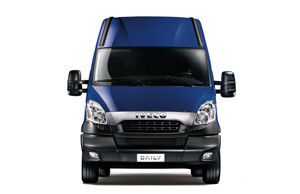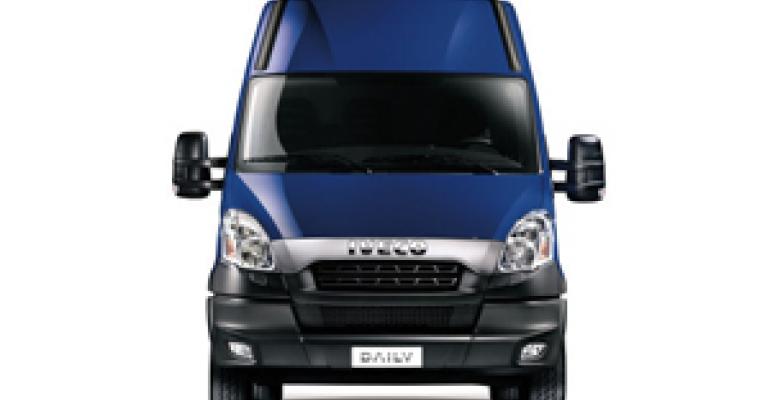
CHELSEA, MI – Chrysler’s Ram brand could see adaptations of two fullsize vans from the Fiat truck family, Ward’s learns.
The auto maker’s product plan suggests two Ram vans will launch next year – one based on the small Class 1 Fiat Doblo and another based on either the front-wheel-drive Fiat Ducato or the Ducato’s brawnier, rear-wheel-drive cousin, the Iveco Daily.
But because the latter offers “different opportunities,” there could be room for more than one, says Bob Hegbloom, recently appointed director-Ram brand product marketing.
“Ducato? Daily? Both?” Hegbloom says, suggesting Chrysler’s vision of Ram is fluid in a fullsize van segment landscape where boxier, upright designs favored in Europe continue to gain traction in the U.S.
Refreshed this year, the Ducato boasts a maximum gross-vehicle-weight rating of 8,818 lbs. (4,000 kg), according to Fiat.
That would be good for fourth place in today’s expanding market behind the Mercedes-Benz Sprinter’s 24,317 lbs. (11,030 kg); the ’12 NV, Nissan’s first North American commercial van, at 9,900 lbs. (4,491 kg); and the 9,500-lb. (4,309-kg) maximum rating of longtime segment sales-leader, the Ford E-Series.
However, Hegbloom says the Ducato has the market’s sweet spot – Class 2 trucks with GVWR of 6,001-10,000 lbs. (2,722-4,536 kg) – well-covered.
“That’s where the big volume is,” he adds. “That’s the largest piece of the pie.”

Through May, Class 2 truck deliveries – including pickups – totaled 637,050, 13.1% ahead of like-2010, according to Ward’s data. General Motors was the volume leader with 47.5% of the segment, followed by Ford with 39.5%.
Chrysler was well back in third with 11%, with Nissan and Daimler, represented by the Sprinter, each clinging to less than 1.3% of the market.
Hegbloom also defends the Ducato because none of its prospective competitors in the U.S. benefit from the compact packaging afforded by a FWD layout.
“So you have the lower load floor,” Hegbloom says. “Getting in and out of it is easier; loading material is much easier.”
Then there is cost of ownership. “Let’s say your driver hits something,” he adds. “The (Ducato’s) whole front fascia comes off with a few bolts.”
And the van is launching this year in overseas markets with two new engines, including a 177-hp 3.0L I-4 turbodiesel that promises, according to Hegbloom, a fuel-economy rating north of 25 mpg (9.4 L/100 km).
Currently, the Sprinter is the only U.S.-market van equipped with a diesel engine – a 188-hp 3.0L V-6 with Mercedes’ trademark BlueTec clean-diesel technology. Though not subject to U.S. Environmental Protection Agency ratings, its combined city/highway fuel-economy is in the range of 20 mpg (11.6 L/100 km), according to Mercedes insiders.
![<link rel="stylesheet" href="http://subscribers.wardsauto.com/galleries/files/lightbox.css" type="text/css" media="screen" />
<script src="http://subscribers.wardsauto.com/galleries/files/prototype.js" type="text/javascript"></script>
<script src="http://subscribers.wardsauto.com/galleries/files/scriptaculous.js?load=effects" type="text/javascript"></script>
<script src="http://subscribers.wardsauto.com/galleries/files/lightbox.js" type="text/javascript"></script>
<p><a href="http://subscribers.wardsauto.com/galleries/2011/sprinter-gallery.jpg" rel="lightbox[plants]" title="2011-2018 Sprinter Share Chart">View Graph Larger</a></p>](http://subscribers.wardsauto.com/images/2011/07/sprinter-share-chart.jpg)
As for the apparent capability disparity between the Ducato and fullsize vans now on sale in the U.S., Hegbloom raises the prospect of a Ram-brand Daily. But he does not promise.
The Iveco Daily boasts a GVWR of up to 15,000 lbs. (6,804 kg), which tiptoes into Class 4.
Meanwhile, Hegbloom says the market might be receptive to a Ram fleet that ranges from Doblo to Daily.
“One thing that you see with the bigger fleets, or even small businesses, is (customers) like to have a one-stop shop,” he says. “So whether they’re buying pickup trucks or cars or they need vans, they want to have a relationship with a product, a manufacturer, a dealership.
“That’s why it’s really important for us to have a full line,” Hegbloom adds.
He confirms Chrysler is closely examining Iveco’s telematics solution for fleet management. The system, developed with Qualcomm, affords real-time transmission of data measuring fuel-consumption, travel distance and engine usage.
Tachograph driver activity data, which is prone to tampering and normally available only through physical access to a vehicle, is protected and accessible by remote download with the Iveco system, the truck brand says.
Chrysler is mum on the future of the recently launched Ram C/V, the brand’s current Class 1 van based on the auto maker’s successful minivan platform.
The Doblo trumps the Ram C/V on maximum payload at 2,205 lbs. (1,000 kg) to 1,800 lbs. (816 kg) – but comes up short on length. The C/V’s cargo space readily accommodates standard plywood sheets, while the Doblo cannot.
General trends suggest the writing is on the wall for the C/V and, perhaps, the aging E-Series.
Both feature low-roof designs that appear to be falling out of favor.
In a move that ignited a firestorm of protest in Canadian labor circles, that nation’s postal service recently chose the Ford Transit Connect over the Canadian-built Chrysler vans.
Like the Doblo, the Transit Connect, which is imported from Turkey, features the boxier profile and accompanying load-space functionality that is favored in overseas markets. And with first-half U.S. deliveries tracking 37.6% ahead of like-2010, the Transit Connect is the hottest-selling vehicle in the small-van segment, as defined by Ward’s.
The Sprinter paved the way for this shift with its 2003 North American debut. The van initially was sold under the Dodge and Freightliner brands during the Chrysler organization’s tie-up with Mercedes parent Daimler.
This marks the nameplate’s second year as a Mercedes product. Second-quarter 2011 saw the Sprinter’s share of the fullsize van segment double to 3.1%, according to Ward’s.
In May, Mercedes cut the ribbon on its 100th U.S. dealership accredited to sell the Sprinter. The van also is sold under the Freightliner brand at more than 50 other outlets.



